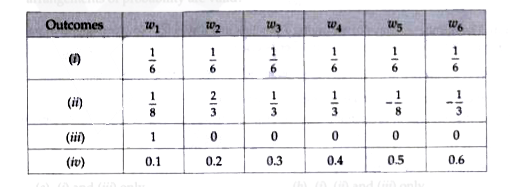Complete Solutions to MULTIPLE CHOICE QUESTION of chapter PROBABILITY of Class 11 book with complete answers and questions
| Class 11 | MATHS |
| Chapter | PROBABILITY |
| ARYA PUBLISHERS | MULTIPLE CHOICE QUESTION |
| Number Of Questions | 36 |
| Academic Year | 2023-24 |
A coin is tossed n times. The number of all possible events is
View SolutionIf the sample space of a random experiment is `S= {w_1, w_2, ..., w_6}`, then which of the following arrangements of probability are valid?

View SolutionThree dice are thrown simultaneously. The probability of getting a total of atleast 6 is
View SolutionThe probability that a non-leap year selected at random will have 53 Tuesday or Wednesdays
View SolutionA card is drawn from a deck of 52 cards. The probability of getting a king or a heart or a red.
View SolutionWhile shuffling a pack of 52 cards, 2 cards are accidently dropped. The probability that missing cards are of different colours is
View SolutionFour cards are drawn from a well-shuffled pack of 52 cards. The probability of obtaininge Windows 3 diamonds and one spade is
View SolutionThe letters of the word "SOCIETY" are placed at random in a row. The probability that three vowels occur together is
View SolutionAn urn contains 9 red 7 white and 4 black balls. A ball is drawn at random. The probability that ball drawn is neither black nor red is
View SolutionA bag contains 20 discs numbered 1to 20. A disc is drawn from the bag. The probability that it bears a prime number is
View SolutionA coin is tossed twice. The probability of getting atleast one tail is
View SolutionIf the odds in favour of an eventare 2:1 then the probability of its occurrence is
View SolutionIf the odds in favour of an event are 4:5, then the probability of non-occurrence of that event is
View SolutionLet `E_1 and E_2` are two mutually exclusive and exhaustive events. If odds are 2:3 against `E_1` then odds in favour of `E_ 2` are
View SolutionEvents A and B are mutually exclusive exhaustive . If `P(E_1) =2/3 P(E_2)` , then the odds in favor of `E_2` are (i) `3 : 1` (ii) `1:3` (iii) `3:2` (iv) `2:3`
View SolutionIf two dice are thrown together, then the probability that atleast one die will show a number greater than 4 is
View SolutionTwo dice are thrown simultaneously. The probability that the sum of the numbers appearing on them is a prime number is
View SolutionA and B throw two dice each. If A gets a sum of 9 on his two dice, then the probability of B getting a higher sum is
View SolutionIn a single throw of three dice, the probability of getting the same number on the three dice is
View SolutionTwo cards are drawn at random from a well shuffled pack of 52 cards. The probability that cards are of different suits is a) `1/221` b) `2/221` c) `39/51` d) `25/52`
View SolutionSix boys and six girls sit in a row randomly. The probability that the six girls sit together is
View SolutionFive boys and four girls sit in a row randomly. The probability that no two girls sit together
View SolutionIf A and B are any two events P `(A cup B) = 2/3 and P (barB) =1/2 ` , then `P(A cap barB)` is
View SolutionIf the probability of A to fail in an examination is `1/5` and that of B is `3/10` , then the probability exactly one of A or B to fail is (i) `11/25` (ii) `19/50` (iii) `1/2` (iv) `3/50`
View SolutionIf A and B are mutually exclusive and exhaustive events and P(A) = `1/3` P(B), then P(A) is equal to (i) `1/4` (ii) `3/4` (iii) `1/2` (iv) `3/8`
View SolutionIf A, B, C are three mutually exclusive and exhaustive events of an experiment such that 4P(A) = 3P(B)=2P(C), then P(B) is equal to (i) `1/13` (ii) `2/13` (iii) `3/13` (iv) `4/13`
View SolutionIn a large metropolitan area, the probabilities are 0.87, 0.36, 0.30 that a family (randomly chosen for a sample survey) owns a colour T.V., a black and white T.V. or both kinds of T.V. The probability that a family own either any one or both kinds of T.V. sets is
View SolutionThe probability of an event A occurring is 0.5 and of B is 0.3. If A and B are mutually exclusive events then the probability of neither A nor B occurring is
View SolutionThe probability that atleast one of the events A and B occurs is 0.6. If A and B occur simultaneously with probability 0.2, then `P(barA) + P(barB)` is
View SolutionA bag contains 150 nuts and 50 bolts. Half of the bolts and half of the nuts are rusted. One item is drawn at random from the bag. The probability that it is either rusted or a bolt is
View SolutionA and B are two mutually exclusive events of an experiment: If P(not A) = 0.65, `P(A cup B) = 0.65` and P(B) = p, then the value of p is
View SolutionThree numbers are chosen at random from the first 20 natural numbers. The probability that their product is even is
View SolutionThree numbers are chosen at random from the first 20 natural numbers. The probability that they are not consecutive is
View SolutionFour digit numbers are formed using the digits 0, 2, 3,5 without repetition. The probability of such a number divisible by 5 is
View SolutionIf A and B are mutually exclusive events, then
View SolutionThe probability that a student will pass his examination is 0.73, the probability of the student getting a compartment is 0.13. The probability that student will either pass or get compartment is
View Solution
MULTIPLE CHOICE QUESTION questions and complete solutions for chapter PROBABILITY of S CHAND MATHS (ENGLISH) of Class 11